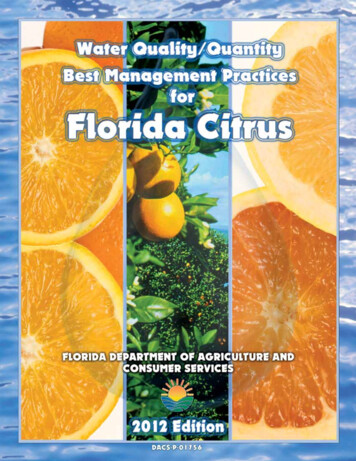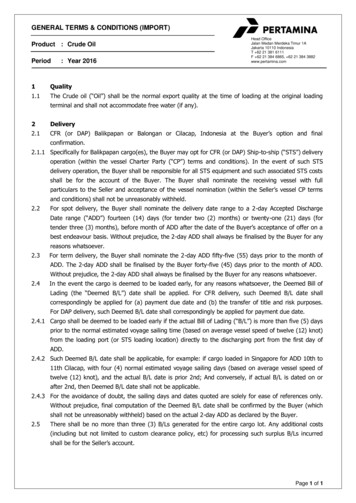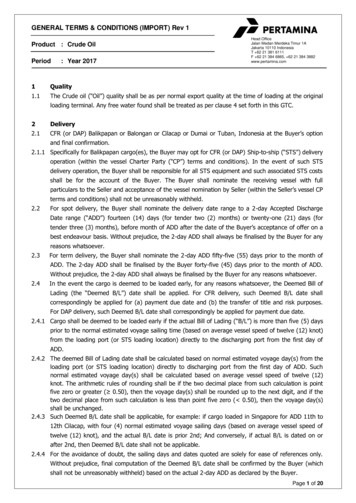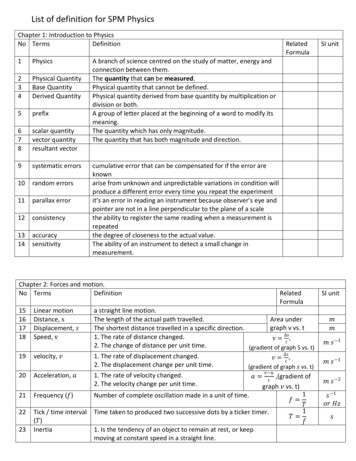
Transcription
Office of the Commissioner(850) 488-3022The Capitol400 South Monroe StreetTallahassee, Florida 32399-0800Florida Department of Agriculture and Consumer ServicesCommissioner Adam H. PutnamComments by Commissioner Adam H. PutnamDear Agricultural Producers:This manual, Water Quality/Quantity Best Management Practices for Florida Citrus, reflects the hardwork of representatives of the industry; federal, state, and local government; and other stakeholders. Ingeneral, agricultural lands maintain valuable water recharge areas and preserve open spaces. The BMPs inthis manual address water quality and quantity impacts from production activities and help maintain theenvironmental advantages of keeping the land in agriculture.While best management practices have been in place for many years in our state, their role inenvironmental protection was formally established in 1999 with the passage of the Florida WatershedRestoration Act. This legislation provides the framework for implementing Florida’s Total MaximumDaily Load program, which sets water quality targets for impaired waters. It also identifies bestmanagement practices implementation as the means for agriculture to help meet those targets.As Florida’s population continues to increase, there are more impacts to and competition for Florida’slimited water resources. All Floridians must take part in conserving and protecting these resources. Thismanual represents the industry’s commitment to do just that.As a native Floridian whose family has long been involved in agriculture, I want to thank all whoparticipated with the Department in the development of this important manual. With the active supportand participation of so many dedicated people, I am optimistic about the future of Florida’s agriculturalindustry. I trust that you will join me in supporting this valuable water resource protection effort.Sincerely,Adam H. PutnamCommissioner of 12 Edition i
AcknowledgementsThis statewide BMP manual for the citrus industry consolidates existing regional programs and extends ruleadopted BMPs for areas of the state not already covered. The following is a list of individuals who participated inthe development of this manual. Each of these individuals and their organizations made important contributionsto the process, and their work is sincerely appreciated.Steering CommitteeBill Bartnick – Florida Department ofAgriculture andConsumer ServicesDr. Brian Boman – University of Florida/IFASDoug Bournique – Indian River Citrus LeagueStaci Braswell – Florida Farm BureauBarbara Carlton – Peace River CitrusGrowers AssociationRon Hamel – Gulf CitrusGrowers AssociationLaurie Hurner – Florida Citrus MutualKerry Kates – Florida Fruit andVegetable AssociationDr. Tom Obreza – University of Florida/IFASRay Royce – Highlands County CitrusGrowers AssociationDr. Mike Thomas – Florida Department ofEnvironmental ProtectionReviewersGlenn Horvath – Suwannee River WaterManagement DistrictLance Laird – Northwest Florida WaterManagement DistrictMark Luchte – Southwest Florida WaterManagement DistrictVince Singleton – St. Johns River WaterManagement DistrictBenita Whalen – South Florida WaterManagement DistrictAdditional ContributorsJames Dodson – Florida Department ofEnvironmental ProtectionMark Mealo – Florida Department ofAgriculture and ConsumerServicesHolly Stone – Florida Department ofAgriculture and ConsumerServicesDr. Kelly Morgan – University of Florida/IFASDr. Steve Futch – University of Florida/IFASEditorTerry Pride – Florida Department ofAgriculture and ConsumerServicesi i W a t e r Q u a l i t y / Q u a n t i t y B e s t M a n a g eme n t P r a c t i c e s f o r F l o r i d a CITRUS
TABLE OF CONTENTSIntroduction. 1Keys to Pollution Prevention. 5User’s Guide to BMP Enrollment and Implementation. 6User’s Guide to BMP Enrollment and Implementation. 6BMP Implementation Follow-Up. 7Best Management Practices. 91.0 Grove Development and Renovation. 112.0 Nutrient Management. 133.0 Irrigation Management. 184.0 Drainage Management. 275.0 Sediment and Erosion Control Measures. 306.0 Water Resources Protection. 327.0 Integrated Pest Management. 35Appendices. 39Appendix I: Acronym List and Glossary. 40Appendix 2: Additional BMP References. 42Appendix 3: Soil and Tissue Testing Information. 43Appendix 4: Citrus Fertilization Tables. 45Appendix 5: Incentive Programs for Qualifying Operations. 46Appendix 6: Chemigation/Fertigation Statutory References. 48Appendix 7: Example Record-Keeping Forms. 49Appendix 8: Contact Information. 51Appendix 9: Chapter 5M-16. 52Appendix 10: Notice of Intent to Implement Water Quality/Quantity BMPS for Florida Citrus. 552012 Edition iii
i v W a t e r Q u a l i t y / Q u a n t i t y B e s t M a n a g eme n t P r a c t i c e s f o r F l o r i d a CITRUS
IntroductionHOLMES JA CKSONGADSDENDUVALKERUNIO NBRADFORD CLAYJOST.TTEEFAYENELAKL INAUSSBAWAKULLATAYLORHNFRANNALT L UMBONSAOOSABIAWALTOKALESCAMSGILCHR ORPINELLASARDBREVPASCOHILINDIAN RIVERHUCOBIESOEEADESOTOHECRHistorical Region-Based FDACS Citrus BMP Programs.LSTHARDEEEEOKNATEHIGHLA NDSMASAMARTINTACHARLOTTECountyGLADESPALM BEACHRidge CitrusLEEHENDRYPeace River and Manasota Basins *BROWA RDCOLLIERIndian River CitrusGulf CitrusMIAMI-DADEMONROEThe citrus industry has had a long-standing rolein BMP development. In 1998, the ProductionCommittee of the Indian River Citrus League,in conjunction with the Florida Department ofAgriculture and Consumer Services (FDACS) andthe University of Florida Institute of Food andAgricultural Sciences (UF-IFAS), took the initiative todevelop BMPs for Indian River Area citrus groves.The objective was to identify practices that havethe potential to improve water quality and reducethe quantity of runoff water draining into the St.Lucie Estuary and Indian River Lagoon. A steeringcommittee was formed to guide the BMP development process. The steering committee consisted ofrepresentatives from FDACS, the Florida Depart-A ROSANTFlorida citrus producers have faced many challenges in the past two decades, including tryingto deal with two severe exotic diseases, citruscanker and greening. Despite these difficulties,the citrus industry has been a leader in embracingBest Management Practices (BMPs) for waterquality and water conservation purposes. Muchof the industry utilizes low-volume under-treeirrigation systems to conserve water, and incorporates precision application equipment into theirnutrient management regimes.NThe State of Florida remains the number one citrusproducer in the country. Most of the industry growsoranges for juice processing; however, the bulk ofthe grapefruit, tangelos and tangerines are grownfor the fresh market.SOOverview of the IndustryERYou can access this manual electronically at www.floridaagwaterpolicy.com.FFSpecific record-keeping requirements are notedusing a pencil icon:JEItalicized words that appear in bolded red italicsare defined in the glossary.Other citrus-producing areas in the state facedtheir own unique environmental issues, and growerorganizations spearheaded the effort to developBMP manuals for the Central Florida Ridge, thePeace River and Manasota basins, and the GulfCitrus area. A stakeholder involvement processsimilar to that used in developing the IndianRiver Citrus BMPs was followed in the other threecitrus areas. The Ridge Citrus rule was adopted inFebruary 2003, followed by the Peace River manualin February 2005, and the Gulf Citrus manual inMay 2007. All regional geographic BMP areascovered prior to the development of this manualare highlighted in Figure 1. This provided theimpetus to consolidate the existing manuals intoa single document that addresses both statewideand region-specific practices for water quality andwater conservation.UNThings to Keep in Mind asYou Use this ManualLHOThis manual is designed for use by commercialagricultural operations that produce citrus crops(oranges, grapefruit, tangerines, tangelos, limes,lemons, or similar citrus cultivars). Citrus nurseriesshould enroll in the Nursery BMP manual adoptedby Rule 5M-6.002, Florida Administrative Code.ment of Environmental Protection (FDEP), the SouthFlorida Water Management District (SFWMD), UFIFAS, the Natural Resources Conservation Service(NRCS), the Florida Farm Bureau, and the IndianRiver Citrus League. The BMPs were adopted inJune, 2002. Because growers were engaged inthe development of the BMP manual, many wereearly implementers of the BMPs once they wereadopted by FDACS.CAOperations Intended to Use this Manual* As of May 2011, flatwood citrus operations not included in another FDACS citrus BMP program may enroll in thePeace River/ Manasota Basins Citrus BMP Program04080120160200MilesFigure 1The citrus industry remains committed to protecting water resources through the implementationof BMPs. This manual, which has been endorsedby industry associations, has been developed topromote BMPs for citrus groves throughout Florida.Although these practices are designed primarily toprotect water quality, some of the BMPs also willhave water conservation benefits.2012 Edition 1
Best Management Practices DefinedBMPs are individual practices or combinations ofpractices that, based on research, field-testing, andexpert review, have been determined to be the mosteffective and practicable means for maintainingand/or improving water quality. BMPs typically areimplemented in combination to prevent, reduce,or treat pollutant discharges. BMPs must be basedon sound science, be technically feasible, and beeconomically viable.BMPs and Water QualityStudies conducted in 2002 by the EnvironmentalProtection Agency (EPA) indicate that nonpointsources (both urban and agricultural) are thenation’s greatest contributors to water pollution.Much of the contribution is due to rainwater carrying pollutants into lakes, rivers, wetlands, estuaries, and groundwater. It is good stewardship andmakes sense for growers to prevent or minimizethese impacts by using BMPs. In fact, the FloridaLegislature has established BMP implementation asthe non-regulatory means for agricultural nonpointsources to comply with state water quality standards.When you implement BMPs you are also confirmingthe Legislature’s support for this approach.Total Maximum Daily LoadsUnder the Federal Clean Water Act and Floridalaw, FDEP must identify impaired surface watersand establish Total Maximum Daily Loads (TMDLs)for pollutants entering these waters. A TMDL establishes the maximum amount of a pollutant that canbe discharged to a waterbody and still meet statewater quality standards. Some pollutants for whichTMDLs have been set include: total phosphorus,total nitrogen, total suspended solids, and coliformbacteria.FDEP may develop and adopt Basin ManagementAction Plans (BMAPs), which contain the activitiesthat affected interests will undertake to reducepoint and nonpoint source pollutant loadings. Inwatersheds with adopted BMAPs, and in someother areas, agricultural producers either mustimplement FDACS-adopted BMPs or conduct waterquality monitoring prescribed by FDEP or the watermanagement district (WMD).Florida already has adopted a significant numberof TMDLs, and many more waterbodies are listedfor TMDL development. This list encompasseslakes, rivers, streams, springs, and estuarine systems. More information on listed waterbodies andadopted TMDLs is available at http://www.dep.state.fl.us/water/tmdl/index.htm. To see a map of BMAPareas and learn more about their development,go to tm. If you need help figuring out whetheryou are in a BMAP area, call (850) 617-1727, ore-mail AgBMPHelp@freshfromflorida.com.Good Agricultural Practices(GAPs) for Food SafetyGAPs have not been incorporated into this BMPmanual. However, this manual recognizes thatGAP programs may play a role in the marketing offresh citrus fruit to some commercial domestic andforeign markets. Therefore, citrus growers shouldbe aware that future GAP standards may exceedthe water quality BMP requirements in this manual,and three sidebars (text boxes) are provided later inthe manual that refer to these points.Benefits of Implementing BMPsBefore FDACS adopts BMPs, the FDEP reviews themand determines whether they will be effective inaddressing water quality impacts from agriculturaloperations. Benefits to enrolling in and implementing FDACS BMPs include: BMP participation demonstrates agriculture’scommitment to water resource protection, andmaintains support for this approach to meetingwater quality and conservation goals. Some BMPs increase production efficiency andreduce costs. Technical assistance with BMP implementation Eligibility for cost-share for certain BMPs (asavailable). A presumption of compliance with state waterquality standards for the pollutants addressed bythe BMPs. Even if EPA numeric nutrient criteriabecome part of state standards, producers whoenroll in and implement the BMPs still have thepresumption of compliance. Release from the provisions of s. 376.307(5),Florida Statutes (F.S.), (fines for damages) forpollutants addressed by the BMPs. The Florida Right to Farm Act (section 823.14, F.S.)generally prohibits local governments from regulating an agricultural activity that is addressedthrough rule-adopted BMPs that growersimplement.2 W a t e r Q u a l i t y / Q u a n t i t y B e s t M a n a g eme n t P r a c t i c e s f o r F l o r i d a CITRUS
Producers who implement FDACS-adopted BMPsmight qualify for exemptions from WMD surfacewater permitting, and/or satisfy other permittingrequirements.Implementation of BMPs does not excuse agricultural operations from complying with applicablepermitting or other regulatory requirements.Permit ExemptionsSome agricultural activities, especially those thatalter on-site hydrology, may require an Environmental Resource Permit (ERP) or other surfacewater permit, for example, the construction of astormwater management system (e.g., retentionor detention pond). Check with your WMDbefore beginning construction of any stormwatermanagement system to see whether a permit isneeded, or whether the following exemptions apply:the authority to make this determination whenever a dispute arises, based on specific statutoryand rule requirements. Under subsection 373.406(9), F.S., environmental restoration activities on agricultural landsthat have minimal or insignificant impacts towater resources may also be exempt from anERP, upon written request by the producer andwritten notification from FDEP or the WMD thatthe proposed activity qualifies for the exemption.Even if an exemption applies, agriculturalproducers within a watershed with an adoptedBMAP that addresses agricultural loadings eithermust implement BMPs or conduct water-qualitymonitoring at their own cost. Under subsection 373.406(2), F.S., any personengaged in the occupation of agriculture mayalter the topography of any tract of land forpurposes consistent with the practice of agriculture. However, these activities may not be forthe sole or predominant purpose of diverting orimpeding surface waters, or adversely impactingwetlands. Agricultural activities that meet thesecriteria may be exempt from an ERP. FDACS has2012 Edition 3
Potential Water Quality ImpactsAssociated with CitrusMany of the groves in Florida have beenconstructed in the flatwoods, which is a landformcharacterized by sandy soils and high water tableswith little relief or slope, thereby requiring drainageinfrastructure. The groves in “interior” Florida aremostly constructed on the Central Florida Ridge,which is a landform characterized by very sandysoils and low water tables, thereby requiringno drainage facilities. These differences createregional production and water quality challenges.NutrientsExcess nitrogen and phosphorus are the mostcommon causes of water quality impairments inFlorida. These nutrients can enter surface watersthrough stormwater or irrigation runoff, or leachthrough soils into groundwater.The nitrogen form most abundant in natural watersis nitrate. Due to its high mobility, nitrate can alsoleach into groundwater. Phosphorus is one of thekey elements necessary for growth of plants andanimals. In terms of freshwater ecology, it tendsto be the (growth) limiting nutrient in non-flowingwaters. Phosphorus is more effectively retained inthe soil than nitrogen. However, phosphorus enterswaterbodies attached to particulate matter viasediment transport, or can be dissolved in water.In some soils, phosphorus is prone to leaching intogroundwater.Excess Algal GrowthAlgae are essential to aquatic systems. As a vitalpart of the food chain, algae provide the nutritionnecessary to support aquatic animal life. Certaintypes of algae also provide habitat for aquaticorganisms. However, high levels of nutrients insurface waters result in abnormal plant growth,including algae. Excess algal production can causemany problems in a waterbody. The presenceof algal blooms, noxious weeds, and too manyfloating aquatic plants can block sunlight necessaryfor photosynthesis by submerged aquatic plants. Ifthere is a mass die off, the decomposition of thesematerials lowers the available dissolved oxygen,which can lead to fish kills.Blue-green algae (Cyanobacteria) can become soabundant that they can cause a scum layer to formon the surface, shading the sunlight-dependent lifebelow and disturbing the food chain. Potential risksfrom recreational contact include skin, respiratory,and mucous membrane irritation.SedimentationSedimentation occurs when eroded soils are washedinto surface waters, creating a buildup of solidson the bottom and suspended solids (turbidity) inthe water column. Sedimentation impacts mostcommonly associated with agricultural operationscome from the erosion of unprotected soils.Sediment can fill in water bodies, clog waterways,carry pollutants, and affect water clarity. Theseeffects combine to reduce fish, shellfish, and plantpopulations, and decrease the overall productivityof lakes, streams, estuaries, and coastal waters.Decreased penetration by sunlight can affect thefeeding and breeding behaviors of fish, and thesediments can clog gills and cause irritation to themucous membranes covering the eyes and scales.As the sediment settles, fish eggs can be buried.Recreational use may also decline because ofreduced fish populations, less visibility, and reduceddesirability of downstream swimming areas.Deposited sediment also reduces the flow capacityof ditches, streams, rivers, and navigation channels,which can require more frequent maintenancedredging or result in flooding. Nutrients andother contaminants can attach to sediments,which can contribute to downstream water qualityimpairments. Chemicals, such as some pesticides,phosphorus, and ammonium, may be transportedin sediment. Over time, these chemicals may bereleased from the sediment and become suspendedin the water column.Organic MatterThe decomposition of excessive organic matter inwater from aquatic plants, algae, or other materialsin runoff can lead to increased biological oxygendemand and lower dissolved oxygen levels. Whereuncomposted manure or inadequately treatedbiosolids are land applied to citrus groves,elevated nutrient and fecal coliform levels mayoccur. The likelihood of contamination is increasedif these materials are applied in excess of agronomicrates, or applied under rainy conditions.4 W a t e r Q u a l i t y / Q u a n t i t y B e s t M a n a g eme n t P r a c t i c e s f o r F l o r i d a CITRUS
Keys to Pollution PreventionIt is the agricultural industry’s responsibility to protect water quality by implementinggood land and water management practices. BMPs include many prevention measuresthat minimize potential water quality and quantity impacts. Implementing BMPs helpsdemonstrate the industry’s commitment to protecting water resources, and garners supportfor this non-regulatory approach. Below are key guidelines for implementing the specificBMPs in this manual.Understand Water Quality Issues on Your OperationWater quality includes chemical, biological, and physical characteristics. Elevated levelsof phosphorus, nitrogen, sediment, bacteria, and organic material contribute to thedegradation of water quality. The potential for discharges from agricultural operations tocause water quality problems varies, depending on soil type, slope, drainage features,nutrient management, and activities in or near wetlands, surface waters, or sinkholes.Grove management practices determine an operation’s impact on water quality. For moreinformation on surface water quality, go to the following link: http://lakewatch.ifas.ufl.edu/LWcirc.html. For information on groundwater quality, go to: http://edis.ifas.ufl.edu/fe601Manage Nutrient Sources ProperlyMinimize the pollutants that leave your property by controlling the types and uses ofmaterials used on your operation. Nutrient-related pollutant discharges can come fromexcessive use or inefficient placement or timing of commercial fertilizer, manure, and/orbiosolids applications. Managing nutrients carefully is critical to protecting water quality.Manage Irrigation CarefullyWater is the carrier for nearly all pollutants. Precisely managing irrigation inputs to keepmoisture primarily in the plant’s root zone will significantly reduce nutrient-related impactsfrom fertilizers. Over-irrigating may exceed the soil’s water-holding capacity and lead torunoff or leaching.Minimize the Potential for Erosion ImpactsLand clearing, culvert installation, road building, ditch and canal maintenance, and groverehabilitation can expose soil and lead to erosion that can increase pollutant loading. It isimportant to take appropriate erosion control measures during these activities.2012 Edition 5
User’s Guideto BMP Enrollment and ImplementationThe steps below will help you select which BMPs toimplement to reduce or avoid negative impacts towater quality coming from your operation.1. Choose the pathway applicable to you: Inthe flowchart below, identify the circumstancesthat apply to you.Is the operation in either EvergladesAgricultural Area of C-139 Basin?(See map below)YesFollow steps 2 - 7 below toimplement BMPs under thismanual and follow SFWMDRule 40-E-63, F.A.C.,NoAll otheroperationsFollow steps 2 - 7below to implement BMPsunder this manualNote: In areas where FDEP has adopted a BasinManagementActionPlan,agriculturaloperations must implement applicable FDACSadopted BMPs or monitor water quality. p.htm for more information.3. Conduct an inventory: The selection of BMPsbegins with a basic inventory of the land’snatural features, structures, and improvementswhich will help you determine how the operationand management of your grove(s) mayaffect environmentally sensitive areas. Whendeveloping the inventory, sketch your grove(s),noting buildings, well locations and other watersources, ditches, retention/detention areas,flow control structures, etc. Identify areas ofparticular concern that need to be addressed.These may include streams, wetlands, springs,sinkholes, and ponded or other poorly drainedareas, among others. You can use the inventoryas a starting point to select the BMPs applicableto your operation. To help you conduct yourinventory effectively, the following tools areavailable:Aerial photographs (http://earth.google.com/99index.html, or other providers)NRCS soil survey maps (http://websoilsurvey.99nrcs.usda.gov/app/)USGS topographic maps (http://topomaps.99usgs.gov)National Wetlands Inventory (http://www.fws.99gov/wetlands/data/index.html)4. Select the Applicable BMPs: Carefully readBMP sections 1.0 through 7.0 and select allof the BMPs in the manual that are applicableto your operation and are technologically andeconomically feasible for you to implement.Record the BMPs on the checklist in Appendix10 of this manual. The checklist includes acolumn for you to schedule BMP implementationif a practice is not already in place.2. Request assistance, as needed, in assessingyour grove(s) and selecting applicable BMPs:FDACS field staff, UF-IFAS BMP ImplementationTeams and Extension Agents, and some Soiland Water Conservation Districts (SWCDs) areavailable to assist you with evaluating whichBMPs are applicable to your operation. To getfree assistance, call (850) 617-1729 or emailAgBmpHelp@FreshFromFlorida.com.The BMPS in this manual focus primarily onmanagement actions, rather than structuralpractices. In general, the BMPs should not requirecost share to implement, though there may be afew exceptions. Depending on the location andspecific conditions of the operation, not all of theBMPs may be applicable to a particular site.It is advisable to consolidate your inventory offeatures, and all your BMP decision-making,including the BMP Checklist, into a simple6 W a t e r Q u a l i t y / Q u a n t i t y B e s t M a n a g eme n t P r a c t i c e s f o r F l o r i d a CITRUS
implementation plan. This can serve as a recordof scheduled and completed BMPs, includingoperation and maintenance activities. A wellthought-out, written plan enables managers andowners to schedule their activities and accomplishtheir objectives. Remember to keep the planavailable and update it regularly. It will help youcommunicate with your employees, your countyextension agent, NRCS staff, or others.5. File a Notice of Intent to Implement (NOI)BMPs: Complete and submit to FDACS a NOI,contained in Appendix 10 of this manual,along with the completed BMP checklist.Once received by FDACS, the Notice of Intentformally enrolls your operation under the BMPprogram. Implementation of the BMPs providesa presumption of compliance with state waterquality standards for the pollutants the BMPsaddress. Implementation includes ongoingrecord keeping and maintenance of the BMPs.6. Implement the BMPs: Implement all applicableBMPs as soon as practicable, but no later than18 months after submittal of the Notice of Intentto Implement.7. Keep Records on BMP Implementation: FDACSrule requires record-keeping to document BMPimplementation. Record-keeping requirementsare highlighted in the manual using this figure:Fertilizer applications and rainfall amountsare two types of record-keeping. All BMP recordsshould be accurate, clear, and well-organized.You may develop your own record-keepingforms or use the ones provided in Appendix 7.You must retain the records for at least 5 years;however, it is desirable to retain records for aslong as possible for your own protection. Alldocumentation is subject to review.BMP Implementation Follow-UpFDACS has developed a BMP “ImplementationAssurance” program to help evaluate how BMPsare being implemented, and to gather feedbackon whether there are obstacles to using any of thepractices. On a cyclical basis by BMP program,FDACS mails surveys to enrollees, which containquestions about BMP-related activities on enrolledoperations. Also, FDACS staff may visit selectedoperations to get more direct input from producers.The Implementation Assurance effort helps in: Documenting the level of participation inimplementing agricultural BMPs. Identifying needs for education and implementation assistance. Reinforcing the importance of BMPimplementation. Evaluating the effectiveness of FDACS BMPprograms. Updating FDACS NOI records.Your participation in these follow-up activities isvital to the continuing success of agricultural BMPprograms in Florida.2012 Edition 7
8 W a t e r Q u a l i t y / Q u a n t i t y B e s t M a n a g eme n t P r a c t i c e s f o r F l o r i d a CITRUS p
GIL CHRIS T PINE LAS B RA DFO Historical Region-Based FDACS Citrus BMP Programs County Ridge Citrus Peace River and Manasota Basin s * Indian River Citrus Gulf Citrus 0 40 80 120 160 200 Miles * As of May 2011, flatwood cit rus operations not included in another FDACS citrus BMP program may enro l in the Peace River/ Manasota Basins Citrus .











